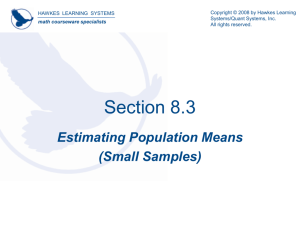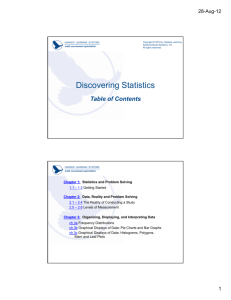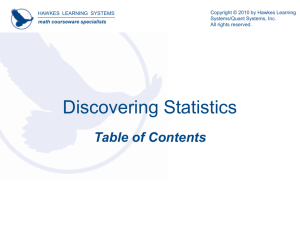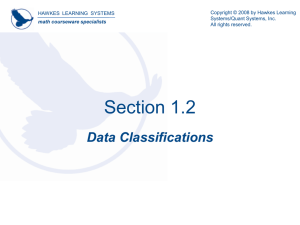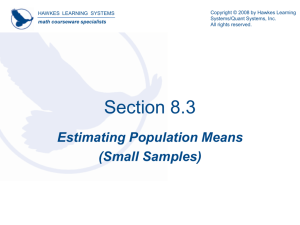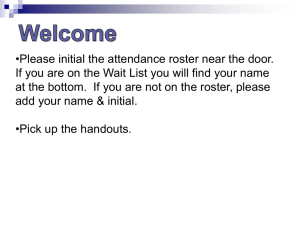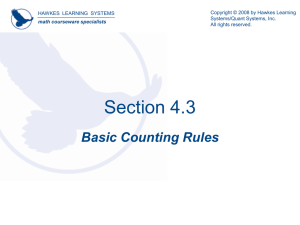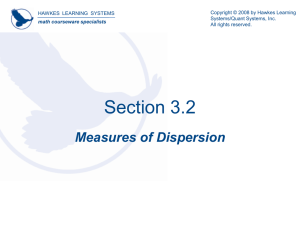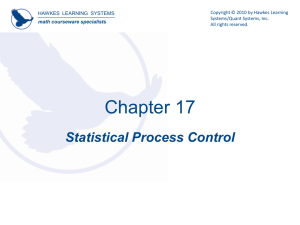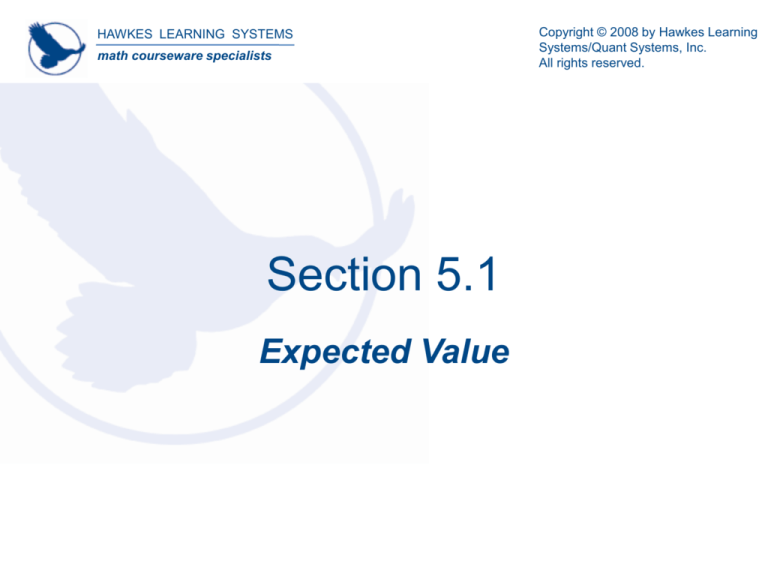
HAWKES LEARNING SYSTEMS
math courseware specialists
Section 5.1
Expected Value
Copyright © 2008 by Hawkes Learning
Systems/Quant Systems, Inc.
All rights reserved.
HAWKES LEARNING SYSTEMS
Probability Distribution
math courseware specialists
5.1 Expected Value
Definitions:
• Random variable – a variable whose numeric
value is determined by the outcome of a random
experiment.
• Probability distribution – a table or formula that
lists the probabilities for each outcome of the
random variable, X.
• Discrete random variable – a variable that may
take on either finitely many values, or have infinitely
many values that are determined by a counting
process.
• Discrete probability distribution – a table or
formula that lists the probabilities for each outcome
of the discrete random variable, x.
HAWKES LEARNING SYSTEMS
Probability Distribution
math courseware specialists
5.1 Expected Value
Create the probability distribution:
Create a probability distribution for X, the sum of
two rolled dice.
Solution:
To begin, list all possible values of X.
Then, to find the probability distribution, we need
to calculate the probability of each outcome.
Rolling Two Dice
x
P(X = x)
2
3
4
5
6
7
8
9
10 11 12
HAWKES LEARNING SYSTEMS
Probability Distribution
math courseware specialists
5.1 Expected Value
Expected Value:
• The expected value, E(X), for a discrete
probability distribution is the mean of a
probability distribution
Formula:
HAWKES LEARNING SYSTEMS
Probability Distribution
math courseware specialists
5.1 Expected Value
Determine the expected value:
You are trying to decide between two different
investments options. The two plans are summarized in
the table below. The left-hand column for each plan gives
the potential profits, and the right-hand columns give their
respective probabilities. Which plan should you choose?
Investment A
Investment B
$1200
P = 0.1
$1500
P = 0.3
$950
P = 0.2
$800
P = 0.1
$130
P = 0.4
–$100
P = 0.2
–$575
P = 0.1
–$250
P = 0.2
–$1400
P = 0.2
–$690
P = 0.2
HAWKES LEARNING SYSTEMS
Probability Distribution
math courseware specialists
5.1 Expected Value
Solution:
It is difficult to determine which plan is better by simply
looking at the table.
Let’s use the expected value to compare the plans.
For Investment A:
E(X) = (1200)(0.1) + (950)(0.2) + (130)(0.4) + (–575)(0.1) + (–1400)(0.2)
= 120 + 190 + 52 - 57.50 - 280
= 24.50
For Investment B:
Best option
E(X) = (1500)(0.3) + (800)(0.1) + (–100)(0.2) + (–250)(0.2) + (–690)(0.2)
= 450 + 80 - 20 - 50 - 138
= 322
HAWKES LEARNING SYSTEMS
Probability Distribution
math courseware specialists
5.1 Expected Value
Variance for a Discrete Probability Distribution:
Standard Deviation for a Discrete Probability Distribution:
Round the variance and standard deviation to one more
decimal place than what is given in the data set.
HAWKES LEARNING SYSTEMS
Probability Distribution
math courseware specialists
5.1 Expected Value
Determine the risk:
Which of the investment plans in the previous
example carries more risk, Plan A or Plan B?
Solution:
To determine which plan carries more risk, we
need to look at their variances.
For Investment A:
x
P(X = x)
x ∙ P(X = x)
x2 ∙ P(X = x)
$1200
P = 0.1
120
144,000
$950
P = 0.2
190
180,500
$130
P = 0.4
52
6760
–$575
P = 0.1
–57.5
33,062.5
–$1400
P = 0.2
–280
392,000
HAWKES LEARNING SYSTEMS
Probability Distribution
math courseware specialists
5.1 Expected Value
Solution (continued):
Using the equation to determine the variance for a
discrete probability distribution we have
= 755,722.25.
For Investment B:
x
P(X = x)
x ∙ P(X = x)
x2 ∙ P(X = x)
$1500
P = 0.3
450
675,000
$800
P = 0.1
80
64,000
–$100
P = 0.2
–20
2000
–$250
P = 0.2
–50
12,500
–$690
P = 0.2
–138
95,220
HAWKES LEARNING SYSTEMS
Probability Distribution
math courseware specialists
5.1 Expected Value
Solution (continued):
Using the equation to determine the variance for a
discrete probability distribution we have
= 745,036.
Since the variance of profits of Plan B is slightly
less than those in Plan A we can conclude that
Plan B carries a slightly lower amount of risk.

